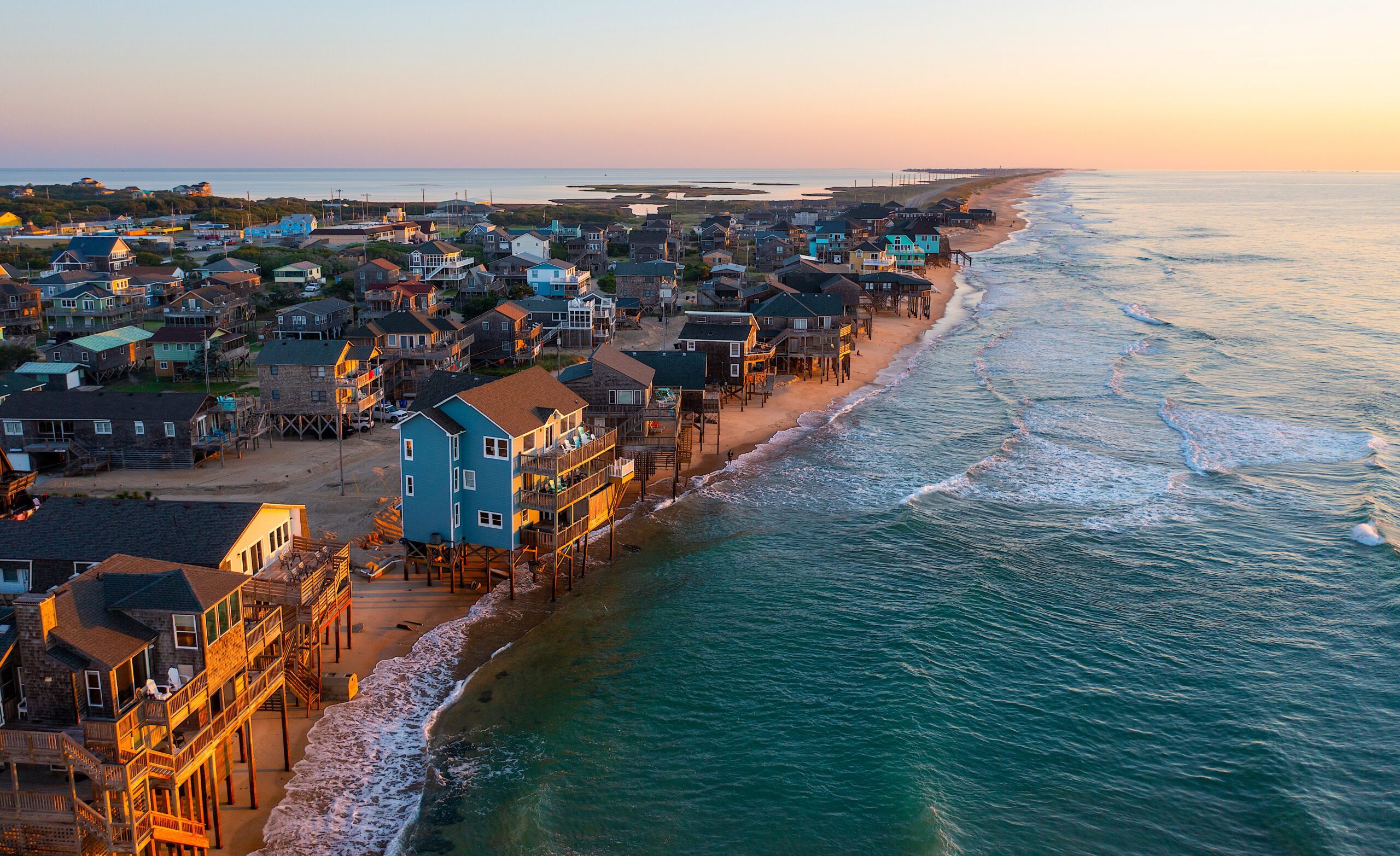From white-capped ocean waves to whitewater mountain rapids, there are millions of reasons to love North Carolina for its nature-blessed beauty.
But North Carolina has much more going for it than any scenic postcard could capture. Beyond the aesthetics are hard-working, natural systems — land, water and air — that sustain life and livelihoods.
Fishing, farming and forestry fueled the state’s economy for the earliest settlers. Today’s more diverse economy still is tied to natural resources for commerce and for the quality of life of its workforce.
North Carolina’s environmental assets are no secret to tourists who pumped $12 billion into the state’s economy in 2004. And, its natural beauty continues to attract a new wave of “settlers” into burgeoning communities from the mountains to the coast. By 2030, state officials expect some 12 million people to call North Carolina home.
Growth has its economic benefits. But many North Carolinians recognize that the boom could be costly in terms of degraded land, water and air quality that often accompany dramatic changes in land use and loss of open spaces.
Now, leaders from across the state are rallying around the “One North Carolina Naturally” banner to help balance the integrity of natural systems with pressures of inevitable growth. Among the flag-bearers are supporters from local governments, state agencies, industry, land trusts and conservation organizations, military reservations, academia and citizen groups.
AN EVOLUTIONARY IDEA
“One North Carolina Naturally” evolved from the N.C. General Assembly’s mandate in 2000 to permanently protect a million acres of farmland, open space and other conservation lands by the end of 2009 — 10 years after then-Gov. James B. Hunt issued the conservation challenge. His “Million Acre Initiative” directed the Secretary of the N.C. Department of Environment and Natural Resources (DENR) to oversee the formidable mission.
In 2002, DENR Secretary William Ross upped the ante — announcing the “One North Carolina Naturally” plan to promote and coordinate long-term programs and strategies to protect land and water resources.
His expanded vision also recognizes the need for conservation strategies for private lands. Options include working with landowners to establish conservation easements on environmentally sensitive tracts.
Ross sees opportunity, as well as urgency, as farms and forests are converted to real estate. In 2005, for example, International Paper announced plans to sell 639,000 acres in North Carolina.
“That, combined with the tobacco buy-out program, represents a huge change, especially in the coastal area,” he notes. “Farmland where tobacco and cotton once grew now is sprouting upscale golfing or boating communities.”
Ross explains the “One North Carolina Naturally” mission is threefold:
- Green Lands, Blue Waters: Protecting and Restoring Natural Areas for Future Generations — The million-acre goal is a keystone piece of this effort to conserve land and water resources for future generations.
- Working on the Water: Protecting and Restoring Sounds and Ocean Habitats — The North Carolina Coastal Habitat Protection Plan, adopted in 2004, is an important part of ensuring the viability of commercial and recreational fishing, tourism, education and other coastal activities that rely on healthy aquatic systems.
- Working Lands: Advancing Stewardship of Farms and Forests — Working farms, forests and recreational destinations require special programs, such as incentives for conservation easements, to help landowners maintain traditional — and sustainable — land uses.
The conservation of public and private lands adds up to mutual benefits, Ross says.
“We are taking a holistic approach to conservation of natural resources. We can set aside a million acres, but if private lands degrade, eventually preserved acreage and waterways will be degraded,” he explains.
MAPPING THE FUTURE
When the initiative was launched, 2.8 million acres of state, federal and private lands were permanently protected. Since then, just over 350,000 acres have been added to the inventory through the collective efforts of nonprofit land trusts, conservation
organizations, state and federal governmental entities, and concerned citizens.
Land acquisition for conservation lags behind schedule, in part, because of shortfalls in the state’s allocation to the N.C. Clean Water Management Trust Fund (CWMTF). The fund was established by the General Assembly to support the million-acre initiative. For the 2005-06 budget cycle, for the first time, CWMTF will be fully funded at $100 million.
“One North Carolina Naturally” is no single-agency operation. Developing an efficient — and cost-effective — comprehensive conservation plan takes grassroots involvement, scientific tools, and the availability of resource materials to support ongoing regional efforts.
Early on, Ross established the Office of Conservation and Community Affairs and tapped Richard Rogers to lead that outreach and educational effort. Beginning in 2002, Rogers facilitated regional meetings across the state both to gather and to provide information about important land-use planning decisions.
At the same time, Rogers says, by working with local and regional groups to identify and address specific needs, the state can set a course that does not conflict with the groups’ goals.
The regional forums, funded by the Z. Smith Reynolds Foundation, resulted in developing the One North Carolina Naturally Consolidated Map that features:
- areas where population growth may be placing pressure on natural resources and open space;
- lands, either publicly or privately owned or managed for open space, such as parks, game lands or agriculture research areas;
- future focus areas with conservation plans based on ecological information; and
- regional plans developed by regional planning efforts.
From the program’s online home page, those interested can quickly link to the map, then zoom in on specific areas in a selected community. Layers reveal critical features such as habitats, water bodies and infrastructure. Future updates will include statewide greenways, canoe trails and boat access points.
The map is an important planning tool, Rogers says. “It clearly shows what has been achieved through public and private efforts. With it, multiple partners can identify opportunities to protect large and small tracts — or areas that connect conservation gaps.”
MONEY TALKS
The state’s conservation groups have employed creative financing since tight budget years have limited the state’s purchasing power.
Most land acquisition relies on state programs, such as CWMTF. The Natural Heritage Trust Fund and the Parks and Recreation Trust Fund share annual proceeds from the state’s deed registry tax. The Farmland Preservation Trust Fund has had limited funding since it was established in 2000.
Bill Holman, CWMTF executive director, says this year’s fully funded budget allocation “will go a long way toward protecting our water resources and making sure North Carolina has a healthy environment and economy.”
Strong public and private partnerships forged through “One North Carolina Naturally” have helped leverage funding during the lean years.
Projects are described on the CWMTF Web site. Data from the analysis of monitored tracts across the state soon will be posted.
“There are real success stories out there,” Holman says. “The genius behind the program is that local communities are engaged in determining what is important to them.”
Some projects lend themselves well to increasing public awareness, he says. A shoreline stabilization project at Carteret County Community College will demonstrate innovative methods. “People will see the methods and the results — more crabs, more birds, more life. Students and other volunteers will be involved with collecting data. Forums will be held to talk about results.”
Holman, former DENR secretary, adds “Clean water is the foundation of our coastal economy. It is critical to protect natural and cultural resources as we grow.”
Planning is key. “It’s essential to include economic and environmental concerns in planning discussions to create communities where future generations will live healthy and prosperous lives,” says Walter Clark, North Carolina Sea Grant coastal policy specialist. North Carolina Sea Grant, he adds, has resources that support “One North Carolina Naturally” by helping communities develop strategies to balance economy and ecology.
“Our Coastal Initiative Program provides research, education and outreach to assist in growth management,” Clark notes.
In addition, the N.C. Coastal Resources Law, Planning and Policy Center is designed to match local needs for legal and policy information with researchers and students in law and planning programs at the University of North Carolina at Chapel Hill, as well as North Carolina Sea Grant.
Tremendous efforts — and an additional stream of funding — are needed to realize the million-acre conservation goal, Holman says.
To that end, Land for Tomorrow — a coalition of conservation groups, businesses and citizens — is seeking legislative support for a plan to finance land acquisition.
The partners recommend that the General Assembly place a $1 billion bond referendum before North Carolina voters in November 2006. The measure would help realize the “One North Carolina Naturally” mission by bolstering the state’s land-buying power over five years.
“If we are successful,” says Kate Dixon, Land for Tomorrow spokesperson, “the monies could be used to leverage federal, local and private matching funds, to build on the existing trust funds, and help local communities create sustainable jobs and a higher quality of life.”
At the end of the day, says Secretary Ross, “One North Carolina Naturally” is about the awareness that we the people are part of the natural system. We the people need to take responsibilities for our actions and do better for our children and for a bright future. We the people can’t live apart from natural systems. We are interconnected and dependent upon them — and inspired by them.”
LEARN MORE ABOUT ‘ONE NORTH CAROLINA NATURALLY’
For more information on “One North Carolina Naturally” and open space conservation efforts, go online to:
- One North Carolina Naturally, DENR, www.ncnaturally.org;
- Land for Tomorrow, www.landfortomorrow.org;
- The Nature Conservancy, www.tnc.org;
- N.C. Coastal Federation, www.nccf.org; and
- The N.C. Coastal Land Trust, www.coastallandtrust.org.
For a complete list of local and regional land trusts, go to The Conservation Trust for North Carolina, www.ctnc.org.
This article was published in the Spring 2006 issue of Coastwatch.
For contact information and reprint requests, visit ncseagrant.ncsu.edu/coastwatch/contact/.
- Categories:


